We had another successful Sgraffito workshop Saturday.
I thought I’d post again, not only for the attendees but also because we covered a couple of new things.
The workshop explored the various ways you can add surface decoration to your pots. We explored ways of making lines in negative and positive ways to make images or patterns; the ideal times to apply slip to your pots, address the differences between the clays and also slip vs. underglazes which can also be used in sgraffito; the best glazes here at Lill and various ways to apply them.
Slip application – It is important to remember that slip is clay therefore it shrinks as it dries-if the surface to which you are applying it, is already bone dry and done shrinking, it will flake off as it shrinks; apply it to leather hard clay or wetter!
The slip at Lill is made of Grolleg Porcelain which shrinks at a slightly different rate than the stoneware. Sometimes, if it’s not properly bonded, the slip can flake off as late as days after it comes out of the glaze kiln.
To make sure it bonds well when applying it to stoneware, apply it as soon as you are able. This can mean painting it on while your pot is still on the wheel or in the mold.
I threw this bowl and immediately applied the slip- then dried the surface so the slip would expand along the lines I incised. Then I pressed outwards under the slip. (photos)
The important thing to remember in this case is that if you are really slathering on the slip- the moisture from it is partially absorbed by the clay beneath it and in certain cases, it can cause your pot to collapse- but that is usually on unsupported surfaces where gravity causes the moisture to go down into the clay.
Most often I am applying slip to freshly made trays in their slump or drop molds and because those are supported (by the mold), that is an ideal time to apply the slip.
If you are painting several layers of slip- like, for example, white and then blue -let them dry to matte in between applications.
Underglaze can behave very much like slip- it doesn’t run and it can be applied to almost any wetness of clay from just thrown to bone dry surface. It will apply differently depending on the surface. Also bear in mind you are not really adding much thickness with underglaze. With slip, you are changing the quality of the surface and giving yourself almost a cushion of surface clay in which to work. The analogy in class was that ink is to paint as underglaze is the slip.
Carving & Scratching. I find it best to carve when the pot is leather hard for several reasons:
- so you don’t breathe in the dust.
- The pot is not as brittle and less likely to develop fine cracks from being handled. Those cracks show up in the glaze firing.
- I like the line quality better.
note* I use fine wire loop tools and wooden sticks. I prefer various sized wooden sticks to a needle tool because you get a lovely variable line quality and because it is easier to control the depth of the line. I have a photo up of my tool kit on my last Sgraffito workshop post.
Some types of Sgraffito carving:
- simple line drawings (note, I “dented” the surface inside the drawing with the rounded end of a tool – I didn’t break through the slip but simply changed the texture.)
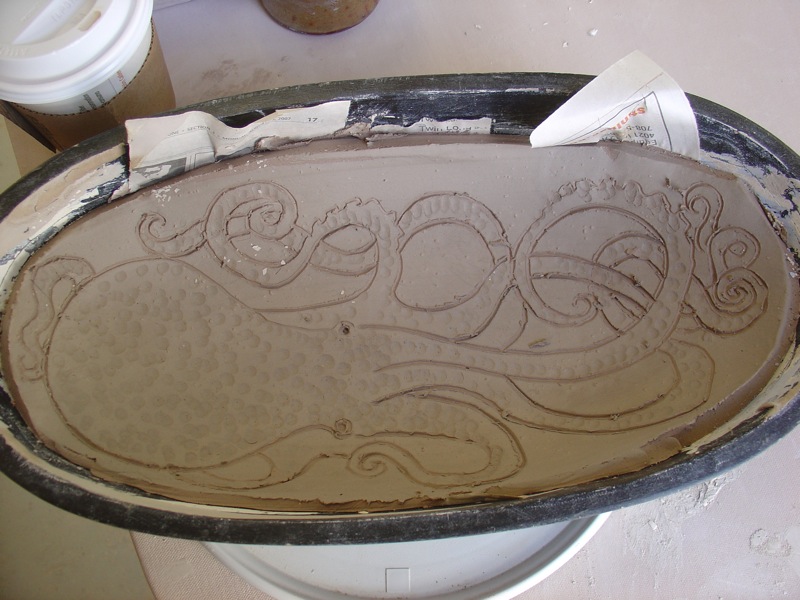
- Stencil with lines incised
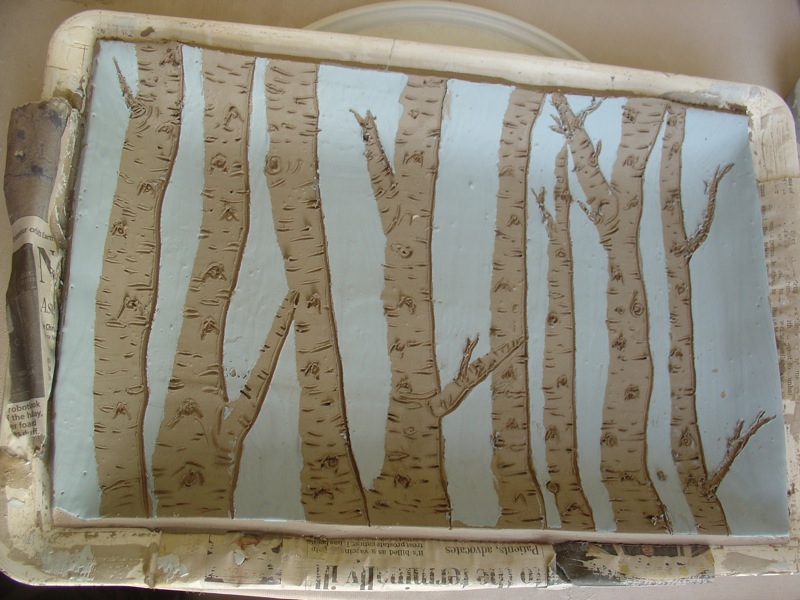
- negative /positive space- this is the type of sgraffito I do the most. I draw an image and then remove the black slip around it with a fine wire loop tool.
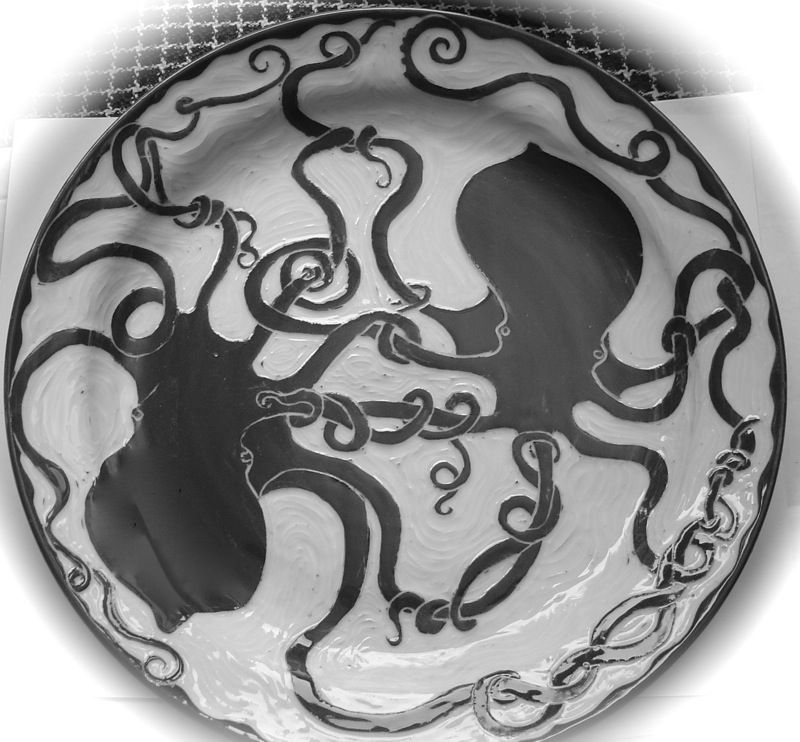
- Minimal sgraffito to clean up painted images
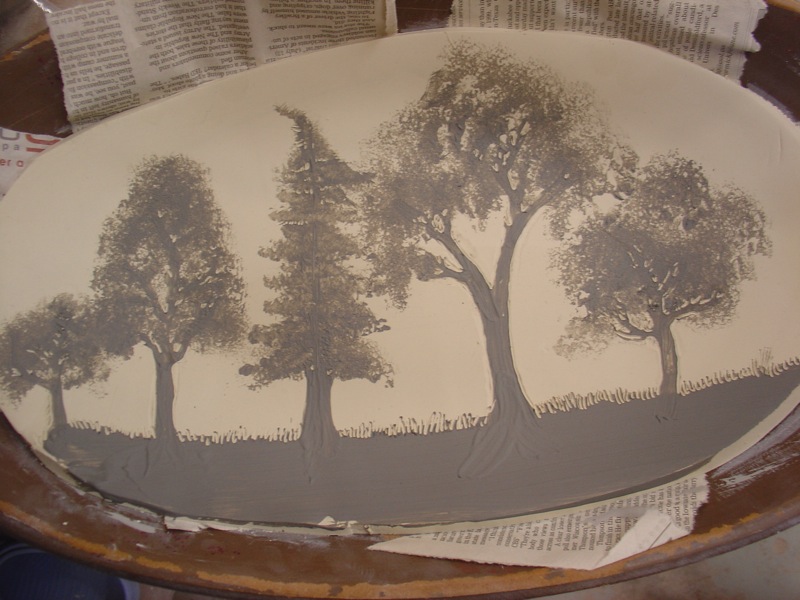
- Inlaid slip-in this case I made the ultra fine lines with an odd toothed wheely-tool on a long rectangular porcelain tray. ( PHOTO of actual work to come) I found out this tool is to make lattice work pastry! You can buy them online on cooking supply websites.
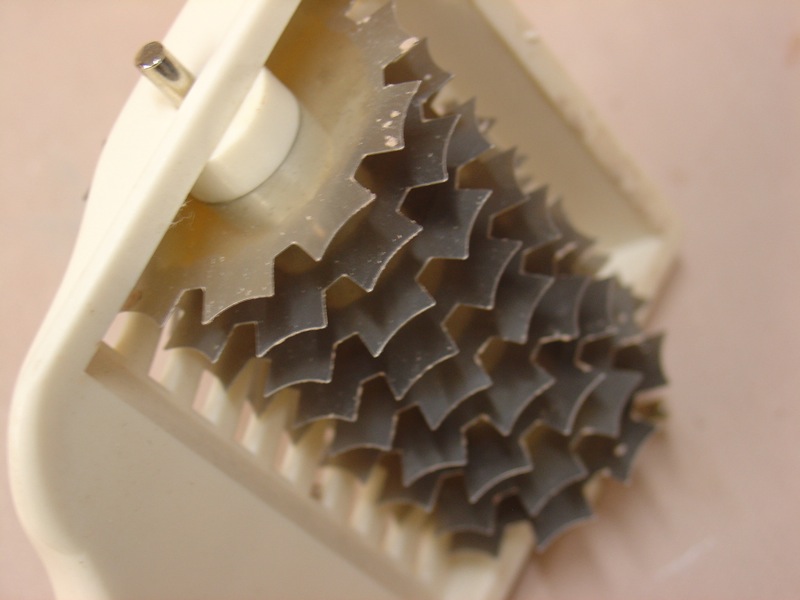
 You can incise a line drawing or pattern into the surface. I painted over the entire surface in black- my students didn’t think that such fine lines would even get the slip in them- I let it dry to almost bone dry (but not quite! remember: the clay is more brittle and prone to break once it loses its flexibility!!) so that the slip was pretty stiff and wouldn’t smear at all and then scraped it off with a metal rib. You should make a conscious decision about the size of the line you are putting in when you inlay slip. A wider cut needs to be deeper also or you will end up scraping out the slip that is meant to be left behind.
You can incise a line drawing or pattern into the surface. I painted over the entire surface in black- my students didn’t think that such fine lines would even get the slip in them- I let it dry to almost bone dry (but not quite! remember: the clay is more brittle and prone to break once it loses its flexibility!!) so that the slip was pretty stiff and wouldn’t smear at all and then scraped it off with a metal rib. You should make a conscious decision about the size of the line you are putting in when you inlay slip. A wider cut needs to be deeper also or you will end up scraping out the slip that is meant to be left behind.
There was considerable discussion about what glazes to use. It is a hard lesson to learn, when you’ve spent hours carving your pot, only to have it disappear beneath an innocent looking glaze job.
Choice of glaze as well as application are key.
It is important to understand that most of the glazes (at Lill) are at an ideal thickness to really give good coverage-which means way too thick for sgraffito! I always rinse my pots in clean water just before dipping them. As the pot is already holding some moisture, this serves to lessen how much glaze they can absorb. Remember, the thinner the walls of your pot, the less moisture you need- it can’t hold much! The opposite undesired result is an application of glaze that is almost non-existent. It runs right off your pot.
I mostly use “breaking glazes” these are glazes that thin at edges or high points and pool in low points.
Here is my list for the Best Glazes for over Sgraffito at Lill:
1.Shaner’s Clear** Again, I lightly rinse my pots in water just before dipping to thin application of glaze. Shaner Clear is especially forgiving of extra drips etc. However; I do find the Clear gives bare Stoneware a dead gray look so I only use it over Porcelain. 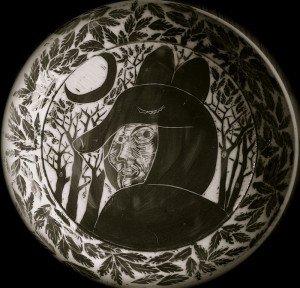
2.Celadon – almost as clear with a green tinge – I use this for Stoneware as it brings out the iron in the clay nicely 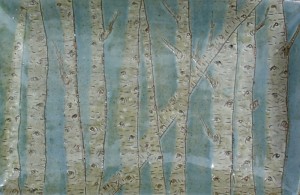
3. either of the Shino’s- here we had a lengthy discussion about application. I often use Shino water (which is soda water) and if I apply the glaze, it must be thin! sometimes I wipe it off with my hand immediately after I dip it. this can give you a very uneven result. 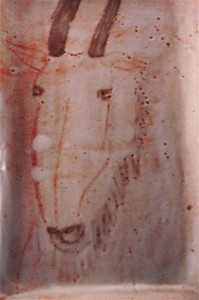 there is quite a range of results that can be achieved with shino.
there is quite a range of results that can be achieved with shino.
here it is over white and also colored slips-note the spots where the glaze is thicker- it is white.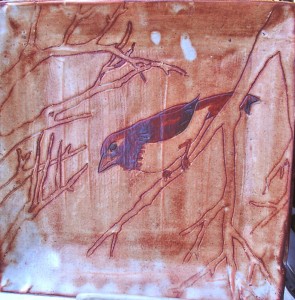
here, it is quite thin and so it is orange.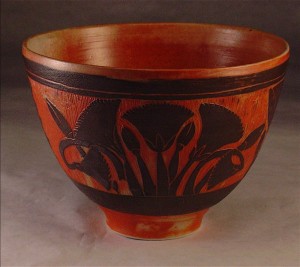
Soda water– also known as “shino water” which is a good non-glaze sealant that also brings out the brown/iron in stoneware. (when I say “sealant”- unglazed porcelain can absorb dirt over time)
4. Josh Green – this is NOT a forgiving glaze every drip will show but again, you can get some great results from it and as with the others, thin is better.
5.Rutile Blue– I prefer this on stoneware actually. 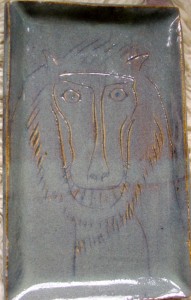 Again, you can see the area where it is thicker.
Again, you can see the area where it is thicker.
6. Shaner white** – this mutes your colors and lines but your work will show through! Don’t forget, I rinsed these thoroughly in water before dipping them.
 This one below is a special case- I threw this vase in B-clay (a mix of stoneware and porcelain) and it turned grey under the clear so for this one I dipped it in Shaner White and rubbed it off all the carving so that the glaze was sort of inlaid. I really like the way it turned out but it was a lot of work and you have to have just the right touch.
This one below is a special case- I threw this vase in B-clay (a mix of stoneware and porcelain) and it turned grey under the clear so for this one I dipped it in Shaner White and rubbed it off all the carving so that the glaze was sort of inlaid. I really like the way it turned out but it was a lot of work and you have to have just the right touch.

**It is important to remember!!, that the Shaner White or Clear absorb red iron! If you have red iron slip decorating your pot and you dip it in clear, much of your pattern will just disappear.
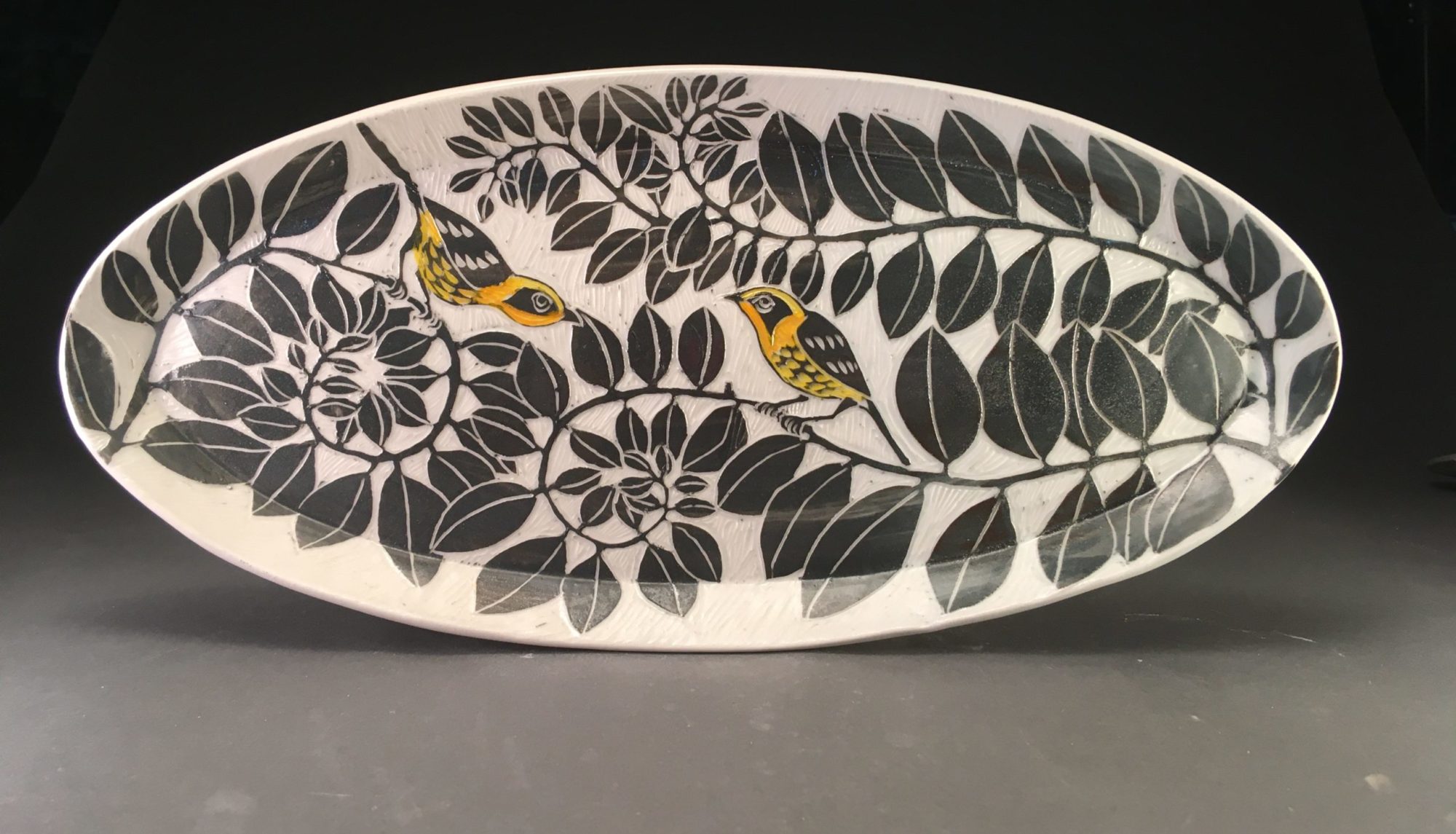
Wow, wow & wow! These are amazing, the detailed description is most helpful. thank you for taking the time.
XO
I am a high school art teacher that is snowed in. These images and advice have inspired me as I am creating my own slip carved designs today.
What a great images. I am a HS teacher too and love that there are some many fun ways to use the sgraffito method. Great post.
Is this for sale?
Linda, this is a 2010 post, so that pot is long gone. For places to get my pots, see my main website. thanks for your interest!